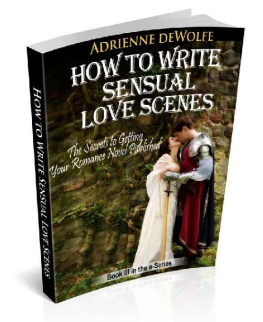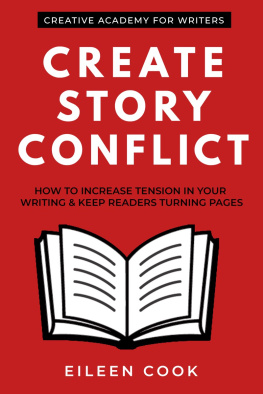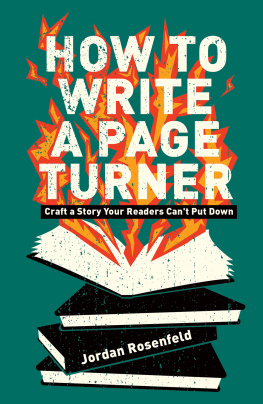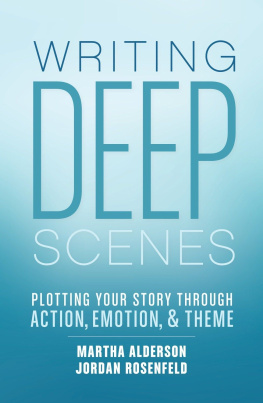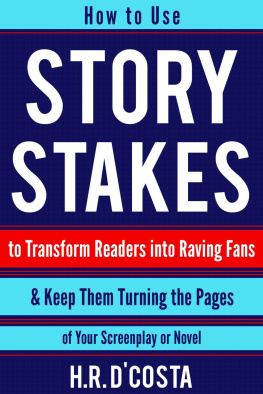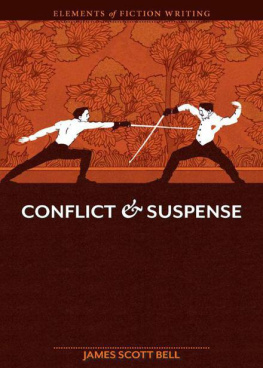You can write your novel with perfect sentences, and deliver heartbreakingly beautiful descriptions containing profound metaphors, but if you dont have tension in your story your reader is likely at any moment to put it down.
1. The narrative does not have an Outer Story.
2. The narratives story arrow from the Outer Story is not clearly articulated.
3. The narratives story arrow is not moving forward.
This ebook explores practical methods, including an amazing five minute trick, that you can use to automatically develop tension in your writing.
INNER AND OUTER STORY
Imagine that youre telling a quieter type of story, in which Justin needs to forgive his father, or Michelle wants to overcome an abused childhood. These are both strong internal conflicts. Theyre both good starts for a novel, but, sadly, by themselves not enough to form the novel. To do this, you need an external story line with a final tangible goal.
How do you add an external story line?
How about this: Justin and his wife move back to care for his ill father who is losing his house due to mistaken accounting. Justin must learn caretaking skills, and fight different battles including the main one with the state, and others with a realtor and with a neighbor. In the final climax, Justin first clears his fathers name then forgives him, allowing the old man to die in peace.
Or this: Michelle decides to build a child-care center for foster abused kids. She is opposed by the lawyer of a powerful neighborhood group that doesnt want to lower the living standards. In the final climax, Michelle is able to overcome all problems to open the center.
In the midst of Justins or Michelles external battles, they also learn to overcome their inner struggles.
Story is comprised of two parts: the Inner Story, and the Outer Story. Both are necessary to have a resonant narrative. Without an Inner Story the story moves from event to event, without exploration of the characters emotional environment. A story like this might mechanically worksome action movies and books do this, as well as puzzle stories like Agatha Christiebut in general, without an Inner Story these generate disposable narratives.
On the other hand, without an Outer Story the narrative will die stillborn. You wont be able to finish your manuscript, or if you do it wont have a point to it.
To have tension you must have an Outer Story: external events occurring in the real story world and topping out at the climax and resolution. Imagine that you have a camera filming your characters. If they are drinking tea and reflecting on events, without moving through anything, you are not showing an Outer Story.
Many would-be authors I talk with are excited about writing a story, but too often what they describe is a premisean interesting character, situation, or story worldwithout an actual external story to go along with this.
For more information on constructing the outer story progression, you can see my book The Story Template .
You can find a list of all Tips on the at the end of this book. Here is Tip #1:
______
Tip #1 : Make sure you include an external story line (Outer Story) in your narrative. The external line should include a Story Goal, Story Stakes, and Story Obstacles (to be discussed in a moment).
______
THE THREE STORY COMPONENTS
The Outer Story always consists of three general components: Story Goal, Story Stakes, and Story Obstacles. Lets look at these.
Story Goal
The Story Goal is the final overriding thing that your hero wants to accomplish in your story. For example, your hero may want to win the dance contest, or neutralize the terrorist (with as little life loss as possible), or find the treasure. Youll notice that these goals are quite specific and their attainment can be answered with a clear yes or no. The Story Goal can be turned into the Story Question:
* WILL Rachel win the dance contest?
* WILL Nathan defeat the terrorist (and save the hostages)?
* WILL Mike be able to find the treasure?
______
Tip #2 : Make sure your Story Goal is specific, and preferably something physical. The Story Goals attainment or lack thereof by the end of the story can be decisively answered with a yes or no.
______
Story Stakes
Your stakes explain why the story is important: if attaining the Story Goal isnt worthwhile, then your hero can just go home and laze around the pool. The Story Stakes must be important to your hero even if your Story Stakes are minor in the scheme of things, they are critical for your hero, and your heros desire causes your reader to also care.
Another point: your heros motives for achieving the story goal are usually altruistic.
You can have multiple Story Stakes for a goalemotional and physical both. For example:
* Rachel wants to win the dance contest so that she can use the prize money to pay for her sisters college education. She also wants to prove to herself that she has overcome her fear of being on stage.
* Nathan wants to win over the terrorist so that the terrorist will no longer hurt people, including the hostages the terrorist is now holding. Nathan also wants to prove to himself that even though hes older hes still relevant.
* Mike wants to find the treasure for historical interesthe would like to donate these priceless treasures to a museum so that many people can enjoy them.
______
Tip #3 : Make your Story Stakes important to your hero so they become important to your reader.
______
Tip #4 : Your hero should want to accomplish something altruistic by achieving the Story Stakes.
______
Story Obstacles
Story Obstacles are the main source of tension in your story, and therefore the main building block of your story. If your hero can automatically walk over and grab the Story Goal, theres no narrative. Obstacles fly furiously through the story, big and small, internal and external, quick solutions and tenacious problems.


